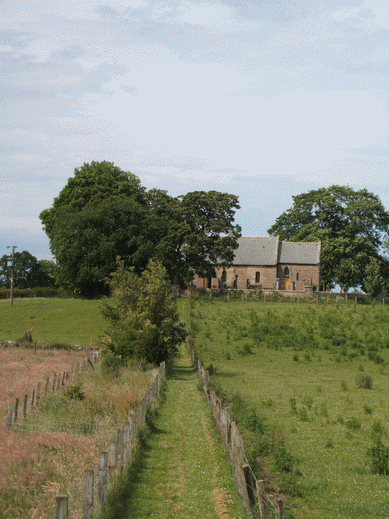 |
|
 |
 |
|
 |
The foundation of the ancient community at Brynneth (what is now known as Birnie) has been attributed to the 'Irish influence' and its dedication has been for centuries to St Brendan (the Navigator). In the Gaelic, 'brenoth' means 'brae or high land' and this obviously relates to the site that the muinntir occupied on top of a rise.
Of the ancient (some say Culdee) foundation there is now no trace which may be the result of it having been a wooden construction. However, the oval outline of the original enclosure seems to be reflected by the older parts of the churchyard's walls. Its antiquity is determined by the presence of a Class I symbol stone (the Birnie Stone) now set into the west wall of the churchyard. A granite stone slightly more than a metre high, it is now badly weathered, but may still be seen to exhibit eagle and z-rod symbols as well as a rectangular device. Fragments of Class III stones are reported to have been found here also but there is now no trace of them. Of equal importance and interest is the Celtic Saint's Bell - Ronnel Bell - a notable tall bell 13" high, in typical cowbell shape. It is presently (5/7/05) in the hands of museum authorities with a view to its conservation. Also, still within the church, in the nave to the north of the chancel arch, is the ancient font. On a more modern plinth, the basin-shaped stone is said to have been in use in the original church of the muinntir and certainly has been dated to these times.
|
|
|
|
|
'Pictish' carved stone - traces showing at the foot of the stone. |
Ancient font from the Celtic foundation. |
Remains of window tracery can be seen here. |
Nearby, at Shougle, is the site of what is, by some, thought to be a Danish Camp and there is supposed to have been a Roman camp with trenches near Bardon (to the east of Glen Latterach).
In the days before the cathedral was finally fixed at Elgin, Birnie was one of the churches used as a cathedral (along with Kineddar and Spynie) and, in 1184, Simon de Tonei, fourth Bishop of Moray, was buried in this church, although no trace of his tomb remains. The ancient church was built in 1140 on the site of the 6th century Celtic Foundation.
Charters show that, some time between 1203 and 1222, Bishop Brice gifted the church of Birnie to Kelso Abbey but this gift seems to have been ineffective and in 1239 it was held as a common church by the Chapter of Elgin Cathedral. In 1331, as a mensal church, it was granted by the bishop for the upkeep of the chaplains of the cathedral.
The present church is, without doubt, one of the most superb examples of Norman architecture preserved in Scotland. It seems very ordinary from the outside and, indeed, there has been much restoration, but within it retains a very present sanctity with its Norman chancel and chancel-arch and overall proportions. This early work is of square, dressed, freestone ashlars. It is a much-loved church and, although it is threatened by falling attendances, it is surely one of the most deserving of buildings in Scotland for preservation. It boasts to be one of if not the oldest churches in the nation with a continuous history of worship within its walls.
Within the church is "the Hairy Bible" so called because of its binding in undressed (still hairy) calfskin and dated 1773. (Presently also in the hands of Museum authorities.)
Today, the church is approached from the new car park to the north but, in more ancient times, the approach was via a narrow path leading from the ancient road which runs to the south of the church. The picture below shows this pathway clearly as it rises towards the church. Walking along this path today you still have the sense of approaching an ancient enclosure.

Ancient path leading up to the church.
The present location of the church is 'remote' but, in ancient times, it was very much on the main road - leading from the west, crossing the River Lossie, going towards Rothes Glen and the rich valley of the Spey beyond and its roads to the south of the country. This more ancient route avoided the considerable marsh-lands which surrounded Elgin (which may not have been much of a township until Viking times), lands which have always been regularly inundated by seasonal floods - a fact which seems to have escaped the notice of the present-day planners and developers!

e-mail: admin@cushnieent.force9.co.uk
© 2005 Cushnie Enterprises